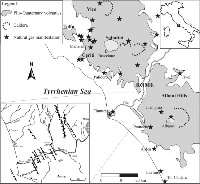Gas blowout from shallow boreholes near Fiumicino International Airport (Rome): Gas origin and hazard assessment
Carapezza M.L., L. Tarchini, D. Granieri, M. Martelli, A. Gattuso, N. Pagliuca, M. Ranaldi, T. Ricci, F. Grassa, A. Rizzo, L. Pizzino, A. Sciarra (2015).
Chemical Geology, 407-408, 54-65, doi: 10.1016/j.chemgeo.2015.04.022.
Abstract
In summer 2013 a toxic and polluting gas blowout (19 tonnes day− 1 CO2, 95 kg day− 1 CH4) occurred from two shallow boreholes drilled at only 50 m from the International Airport of Rome (Italy), in the town of Fiumicino. Another gas blowout occurred in the same period from a borehole located offshore, 2 km away, also generating sea-water acidification; it lasted only a couple of days. Onshore, CO2 was also diffusing from holes within the soil, particularly toward the airport, generating a soil flux up to 1.8 tonnes day− 1. In 3.5 months ~ 1500 tonnes of CO2 and 5.4 tonnes of CH4 were emitted in the atmosphere. Temporal monitoring of gas geochemistry indicates that in this area a mixing occurs between shallow and pressurized gas pockets, CO2-dominated, but with different chemical (i.e., He/CH4 ratio) and isotopic (3He/4He, δ13C-δDCH4) characteristics. Numerical simulation of CO2 dispersion in the atmosphere showed that dangerous air CO2 concentrations, up to lethal values, were only found near the vents at a height of 0.2 m. Fiumicino is a high blowout risk area, as CO2 rising through deep reaching faults pressurizes the shallow aquifer contained in gravels confined underneath shales of the Tiber delta deposits. The Fiumicino blowout is a typical example of dangerous phenomenon that may occur in urban context lying nearby active or recent volcanoes and requires quick response on hazard assessment by scientists to be addressed to civil protection and administrators.
http://www.sciencedirect.com/science/article/pii/S0009254115002405


